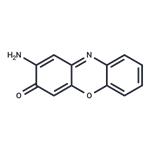Description
Questiomycin A is a phenoxazine and a chromophore that has been found in
Streptomyces and has antibacterial and anticancer activities. It is active against
M. scrofulaceum,
M. marinum, and
M. intracellulare (MICs = 2.8, 11.3, and 5.6 μg/ml, respectively) but not
M. tuberculosis,
M. smegmatis,
M. kansasii, or
M. fortuitum (MICs = >45 μg/ml). It is also inactive against
E. coli,
P. aeruginosa,
S. tymphimurium,
S. aureus, or
L. monocytogenes. It is cytotoxic to a variety of cancer cells, including MCF-7, A549, MIA PaCa-2, and LoVo-1 cells (IC
50s = 1.67, 5.48, 7.16, and 20.03 μM, respectively) as well as human umbilical vein endothelial cells (HUVECs) but not human embryonic lung fibroblast cells (HELs; IC
50s = 16.06 and >50 μM, respectively). Questiomycin A reduces the increased intracellular pH in a variety of cancer cell lines, as well as in HUVECs and HELs. It prevents lung metastasis in a B16 mouse melanoma model of metastasis when administered at a dose of 0.5 mg/kg simultaneously with B16 cells or every three days. It is also a chromophore product of the reducing agent 2-aminophenol oxidation (as 2-amino-phenoxazine-3-one) and has been used as a readout in the study of catalytic oxidation of 2-aminophenol by various metal-containing complexes. It has an absorbance of 435 nm in methanol.
Uses
Questiomycin A is a natural antimicrobial agent produced by agriculturally important species such as maize, rye, and wheat.
Uses
Questiomycin A is a phenoxazine produced by several Streptomyces species and some fungi and bacteria. Questiomycin A is weakly active against bacteria, fungi, plants and tumour cell lines, and inhibits aromatase and sulfatases. Questiomycin, like other phenoxazines, stimulates cell growth and turnover in vitro, an activity possibly related to their ability to form stable free radicals. More recently, questiomycin A has been shown to inhibit pulmonary metastasis caused by mouse melanoma cells. Questiomycin A and related phenoxazines are important dereplication standards in discovery research to eliminate leads due to high amounts of weakly potent actives.


